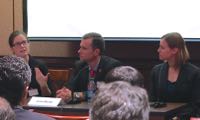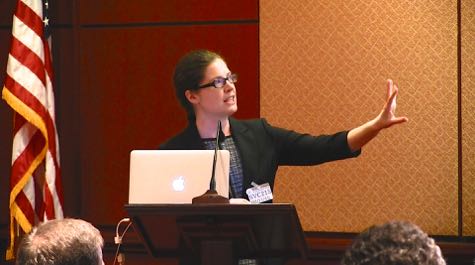VIMS researcher briefs Capitol Hill on coastal flooding
Researcher Molly Mitchell of the Virginia Institute of Marine Science visited Capitol Hill in early March to brief congressional staffers and other concerned parties about the nation’s coastal flood risk.
Joining Mitchell in an event organized by the American Meteorological Society were Jamie Rhome of the National Hurricane Center and Kristin Baja of the Baltimore Office of Sustainability. The briefing, which took place in the Capitol Visitor's Center, was co-hosted by the Association of State Floodplain Managers, the Coastal States Organization, and the Consortium for Ocean Leadership.
 During the briefing, Mitchell introduced the science and impacts of coastal flooding, while Rhome discussed effective strategies for communicating flood risk to the public and Baja described flooding in her city and steps for helping localities become more resilient. In the audience were staffers from 9 Senate and 5 House offices, as well as representatives from NOAA, the World Bank, the EPA, the Congressional Research Service, the American Planning Association, the Smithsonian, the U.S. Navy, and the U.S. Geological Survey.
During the briefing, Mitchell introduced the science and impacts of coastal flooding, while Rhome discussed effective strategies for communicating flood risk to the public and Baja described flooding in her city and steps for helping localities become more resilient. In the audience were staffers from 9 Senate and 5 House offices, as well as representatives from NOAA, the World Bank, the EPA, the Congressional Research Service, the American Planning Association, the Smithsonian, the U.S. Navy, and the U.S. Geological Survey.
Mitchell distinguished between “nuisance flooding,” recurrent bouts of slightly elevated coastal waters with relatively minor impacts, and storm-surge flooding, the infrequent but potentially catastrophic inundation caused by hurricanes and nor’easters.
Mitchell was lead author of VIMS’ 2013 report to the General Assembly on recurrent flooding in Tidewater Virginia. Along with Dr. Carl Hershner and other members of the Center for Coastal Resources Management at VIMS, she plays a key role in ongoing efforts by the Virginia Coastal Policy Clinic—a partnership between VIMS, the William & Mary Law School, and Virginia Sea Grant—to help the Commonwealth respond to coastal-flooding issues and improve the resiliency of Virginia’s coastal communities.
Mitchell says that her briefing drew some materials from the recurrent flooding report, but approached the issue from a different angle. “My briefing focused on the observed increase in nuisance flooding, with sea-level rise just one factor that will make it worse, while our report focused more on the causes and consequences of sea-level rise itself.”
“My take home message,” she says, “was that nuisance flooding is becoming an increasing problem, and that it is already starting to have impacts in many areas.” To prove her point, Mitchell cited data from two recent studies showing an increase in nuisance flooding in cities all along the U.S. Atlantic and Gulf coasts.
In Norfolk, Virginia, for instance, nuisance flooding—defined in the study as the number of hours per year with sea-level at least 1 foot above the normal high tide—has increased 577% since the 1970s, with water levels now exceeding the 1-foot threshold more than 120 hours per year.
“Nuisance flooding is the issue that led Norfolk to push the state to take action,” says Mitchell. “They are starting to see that their roads are closed more often than they used to be, and this is impacting business.”
Mitchell says she also used the briefing to stress that the increase in nuisance flooding has important implications. “Even in areas where we don’t see a lot of impacts right now, we do expect flooding to become a bigger issue in the future,” she says. “It’s something that’s currently not explicitly considered in infrastructure projects, but we’re probably at a point where we need to start thinking about flooding when we design our roads, buildings, and sewer systems.”
Not surprising given the venue, Mitchell says her post-briefing questions focused on policy options for dealing with coastal flood risks. “I only got one technical question about sea-level rise and flooding,” she says, “everything else was slanted toward policy—how people are planning, how different agencies and localities are integrating their efforts.”
Mitchell says the main question was how the Hampton Roads area is integrating with the Navy. “The audience’s biggest interest was how the Navy’s response to coastal flooding is influencing Hampton Roads, and how what Hampton Roads is doing is intersecting with the Navy,” she says.


